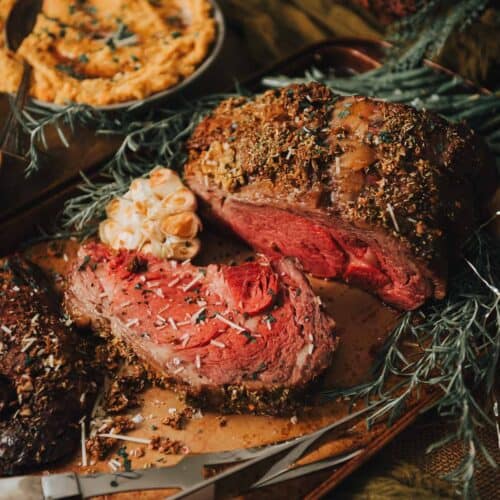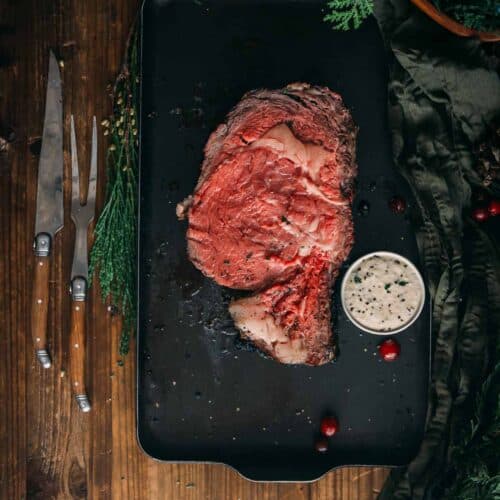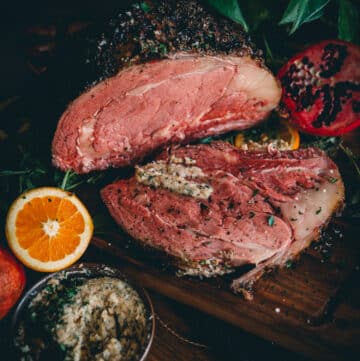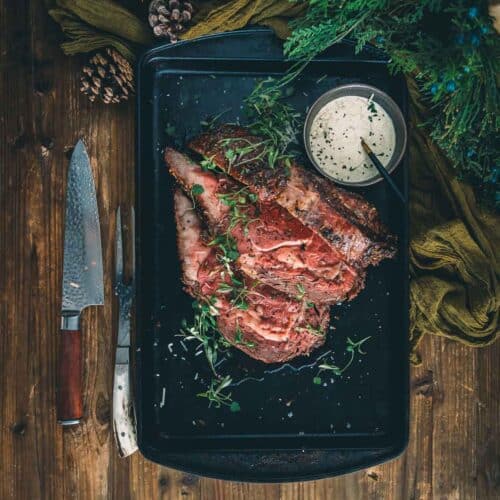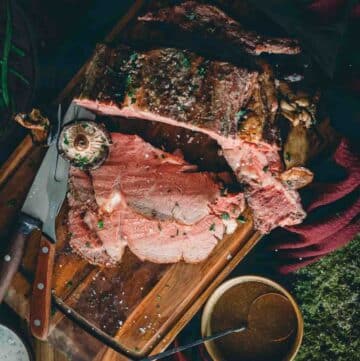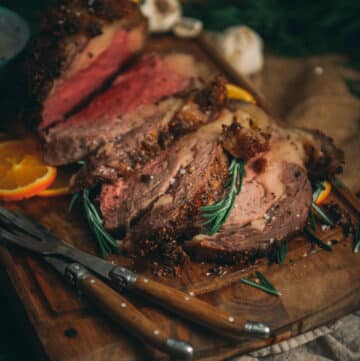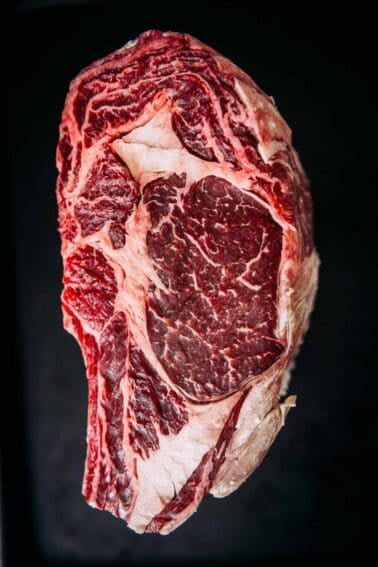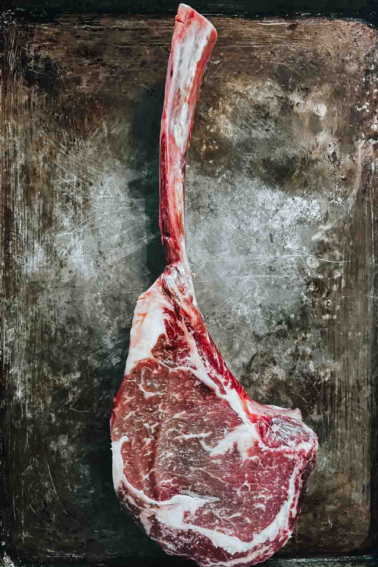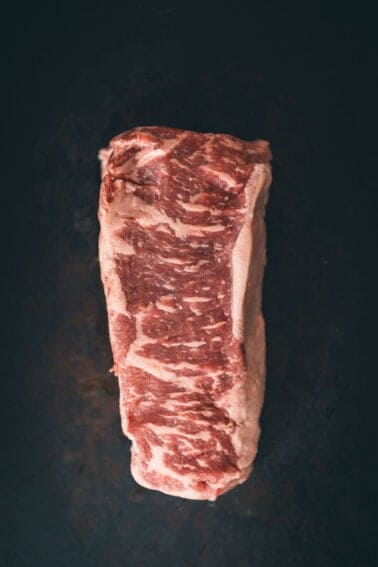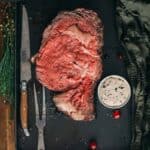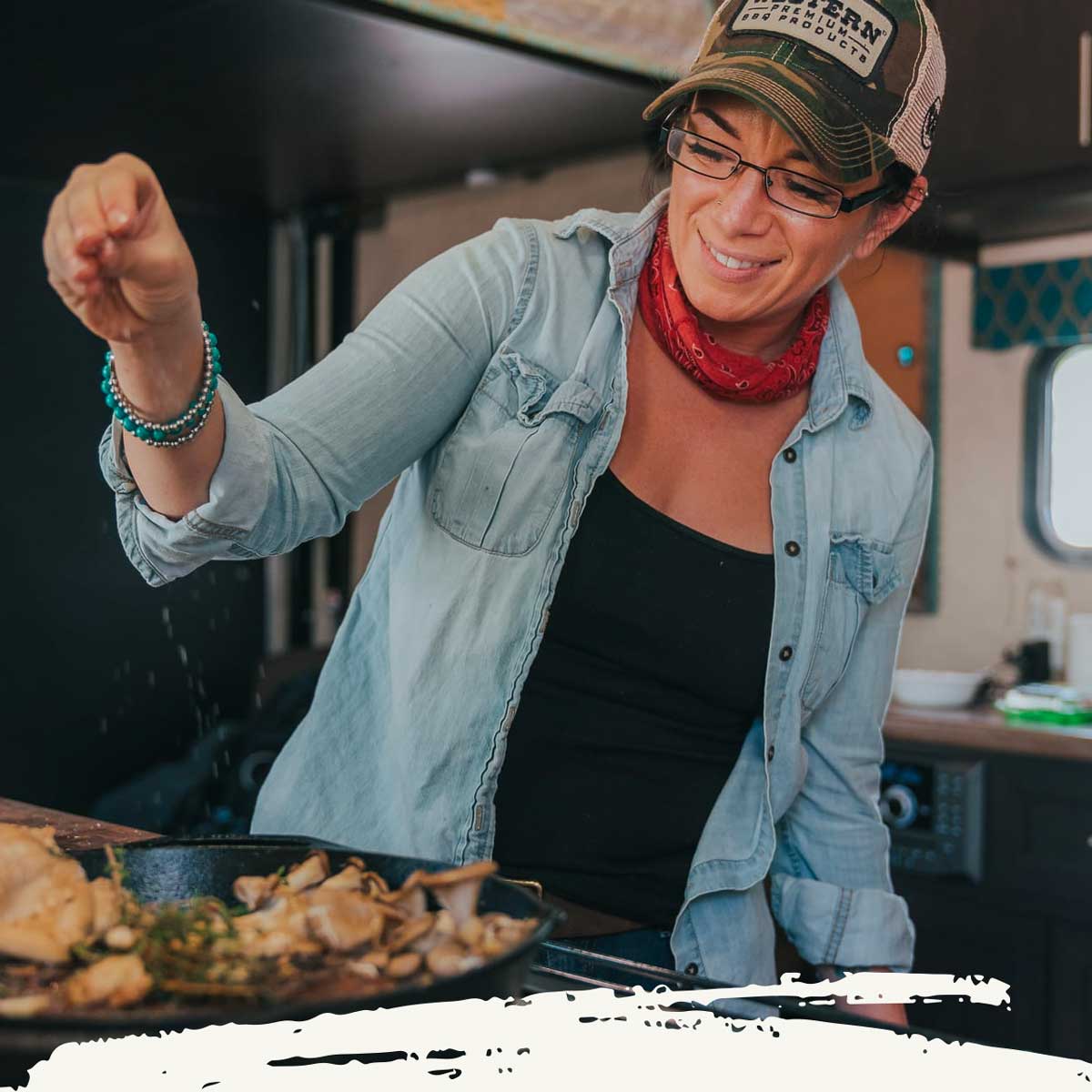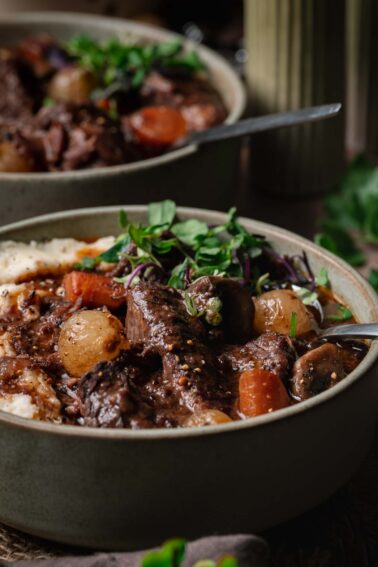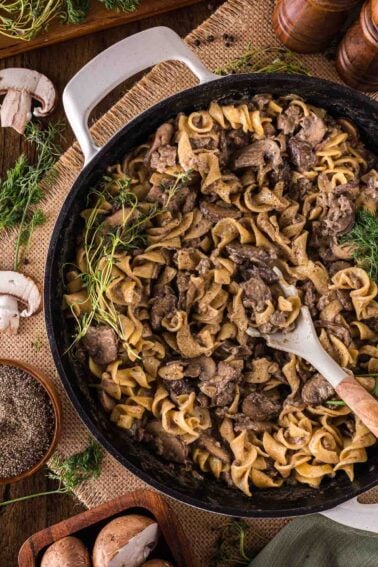Prime rib is the showstopper of beef roasts—rich, tender, and packed with the kind of flavor that makes the whole table go quiet. If you want a roast worthy of a holiday spread (or any night when you want to show off a little), this guide walks you through everything: what to buy, how to season it, every way to cook it, and how to carve it cleanly once it’s rested.
Start Here: Prime Rib Quick-Guide
- Best beginner recipe → Oven Prime Rib
- Best for even doneness → Reverse Sear
- Best smoky → Smoked Prime Rib
- Best for pellet grills → Pellet Grill Prime Rib
- Best for gas grill → Gas Grill Smoked Prime Rib
- Precision method → Sous Vide Prime Rib
- How to carve → Carving Guide
- Buying amounts chart
- Temp & doneness chart
Buying Rule: 1 lb bone-in per person
Target Doneness: Pull at 125–130°F for medium-rare after resting
Seasoning Move: Heavy salt + dry brine 24–72 hours
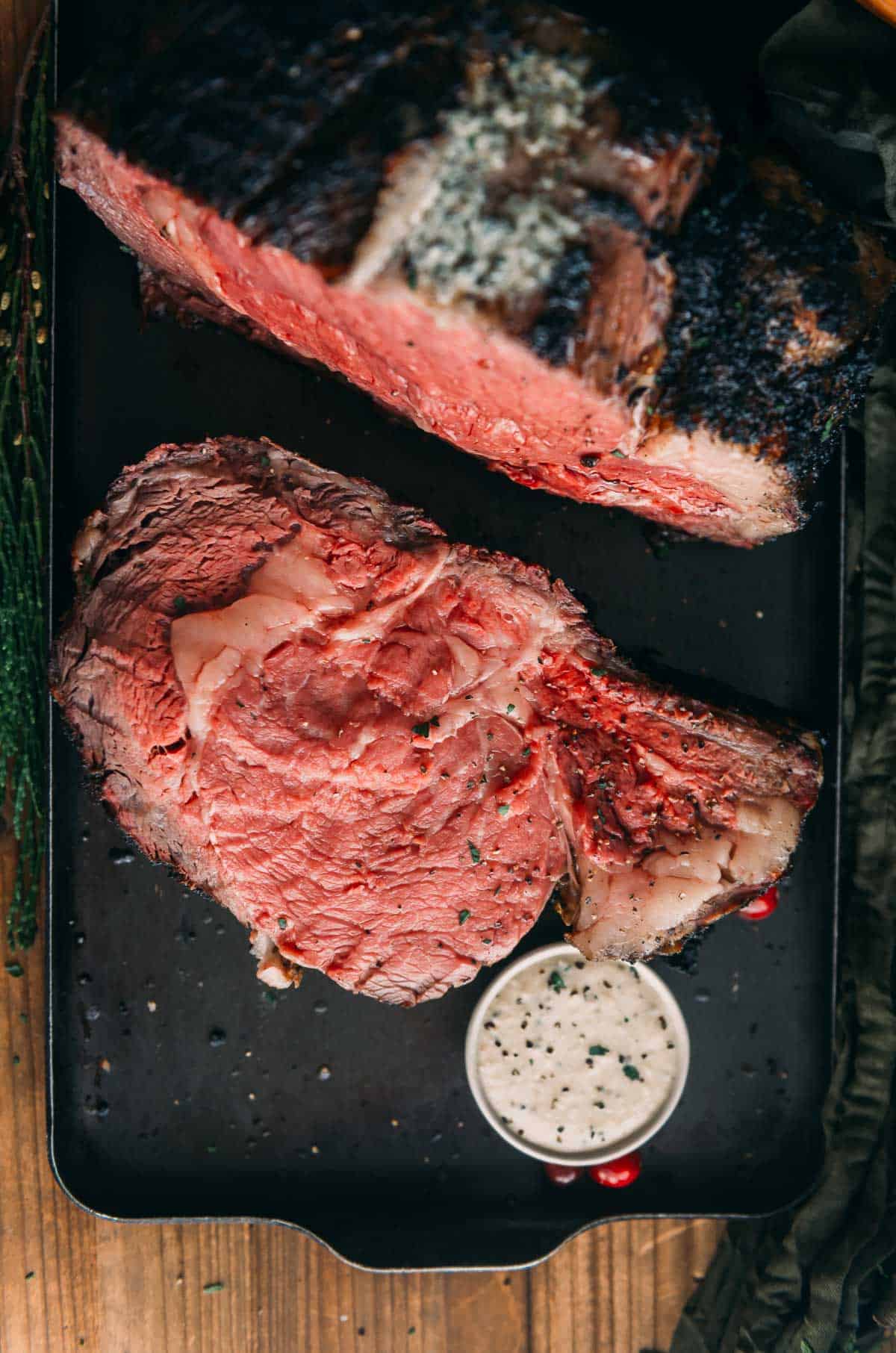
Table of Contents
- Start Here: Prime Rib Quick-Guide
- 🥩 THE CUT: WHAT IS PRIME RIB?
- 🛒 How to Buy the Right Prime Rib
- How Much Prime Rib to Buy
- Marbling
- Beef Grade
- Bone-In vs Boneless
- Sizing
- Holiday Buying Tip
- Save Money
- girl carnivore expert tip
- 🧂 How to Season Prime Rib (Dry Brine Guide)
- 🔥 How to Cook Prime Rib (Choose Your Method)
- Oven-Roasted Prime Rib
- Reverse Sear Prime Rib
- Smoked Prime Rib
- Grilled Prime Rib
- Prime Rib on a Pellet Grill
- Prime Rib on a Gas Grill
- Sous Vide Prime Rib
- ⏱️ Prime Rib Cooking Temps + Doneness Guide
- Prime Rib Cooking Time Chart (General Guidelines)
- Target Pull Temps
- Resting Time
- After Cooking: How to Carve Prime Rib
- 🔪 How to Trim Prime Rib
- 🍽️ Prime Rib Sauces
- 🥦 Best Side Dishes for Prime Rib
- girl carnivore expert tip
- 🍷 Wine Pairings for Prime Rib
- 🍖 What Else Is Prime Rib Good For?
- More helpful Meat Guides
- ❓ Prime Rib FAQs
- The Best Prime Rib recipes
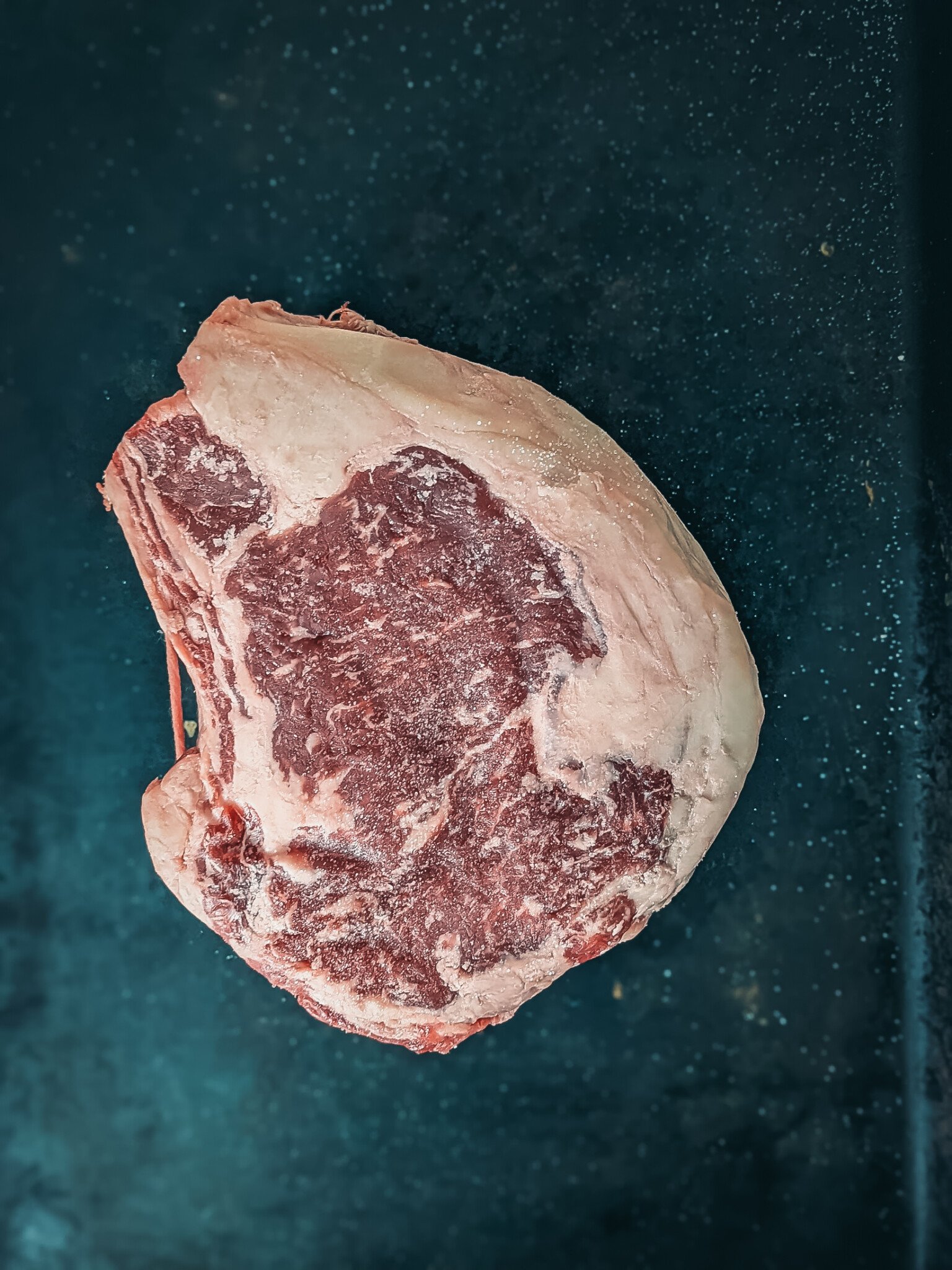
In this recipe:
🥩 THE CUT: WHAT IS PRIME RIB?
Prime rib is a standing rib roast cut from ribs 6–12, known for its marbling and tenderness.
Prime rib—also known as a standing rib roast—comes from the rib primal (ribs 6–12), the same region that gives us ribeye steaks. It’s prized for its marbling, rich beef flavor, and natural tenderness.
A classic prime rib roast is:
- Bone-in or boneless
- Well-marbled
- Covered with a fat cap that bastes the roast as it cooks
It’s not called “prime” because of the USDA grade—it’s called prime because of where it’s cut. You can buy Prime, Choice, or Select grade prime rib. The grade simply tells you how much marbling you’re getting. To learn more about grading, check out our guide to USDA grades of beef.
🛒 How to Buy the Right Prime Rib
How Much Prime Rib to Buy
| Roast Style | Amount Per Person | Notes |
|---|---|---|
| Bone-in | 1 lb per person | Includes bones + shrinkage |
| Boneless | ¾ lb per person | Easier carving |
| Hungry crowd | + ½ lb per person | Holidays, big appetites |
Choosing the roast is half the battle. Look for:
Marbling
The more intramuscular fat, the better the flavor and tenderness.
Beef Grade
- USDA Prime → most marbled, most expensive
- USDA Choice → great balance of quality and price
- USDA Select → leanest, least marbled
Pro Tip: Choose Choice or Prime if possible. Look at the rib cap—if it’s well-marbled and bright red, you’ve got a winner.
Bone-In vs Boneless
- Bone-in: More impressive, helps protect the meat, cooks slightly slower
- Boneless: Easier to carve, cooks more evenly
Sizing
Plan for 1 lb per person on a bone-in roast.
Holiday Buying Tip
Prime rib often goes on sale around Christmas and New Year’s—check local flyers or order ahead from a trusted butcher, just like beef tenderloin.
Save Money
Buying a whole rib roast and breaking it down yourself (or trimming it yourself) can cut costs.
girl carnivore expert tip
If you want to save a buck, you can also trim the whole beef rib roast yourself.
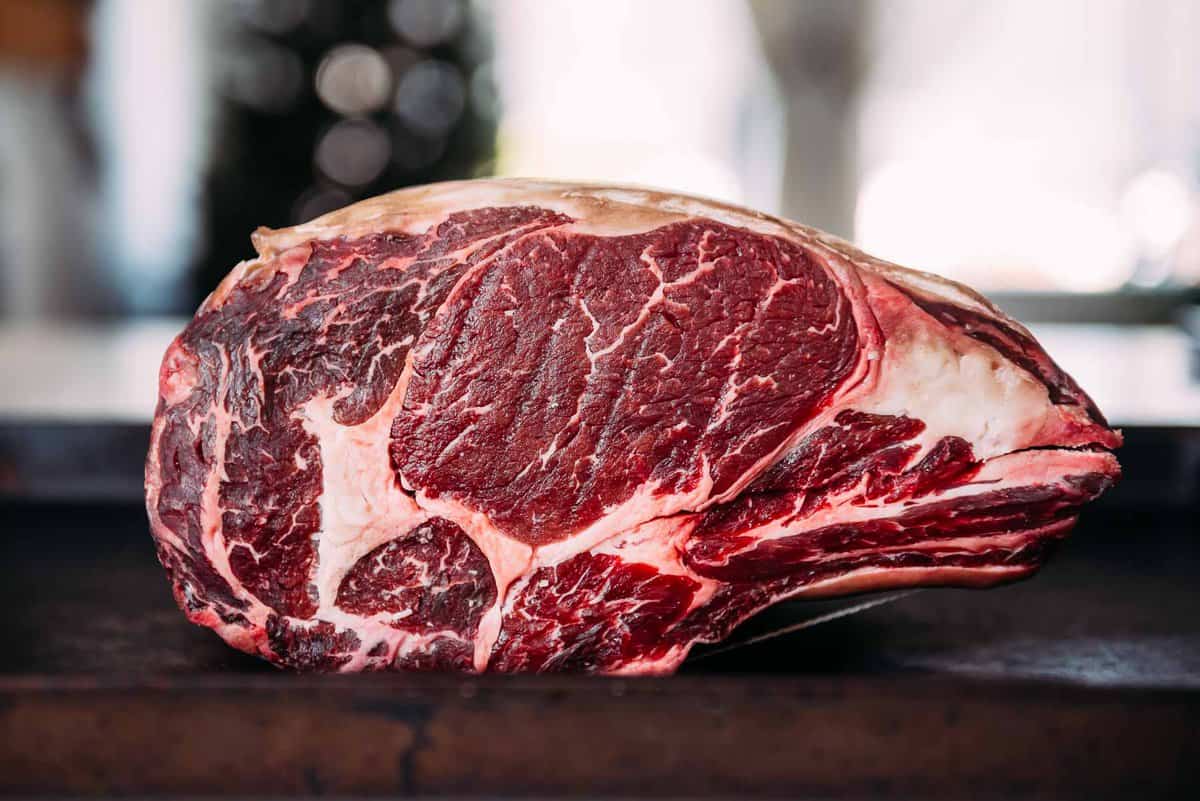
🧂 How to Season Prime Rib (Dry Brine Guide)
Seasoning should be simple and deliberate.
Basic Seasoning
- Kosher salt
- Fresh cracked black pepper
Dry Brine
Salt the roast generously and let it sit, uncovered, in the fridge for 24–72 hours. The salt penetrates deeply, dries the exterior for better browning, and gives you that restaurant crust.
When to Add Herbs
Add garlic, herbs, or compound butter after the dry brine, right before cooking.
Seasoning Guide
Learn exactly how we season our prime rib for the best crust and flavor.
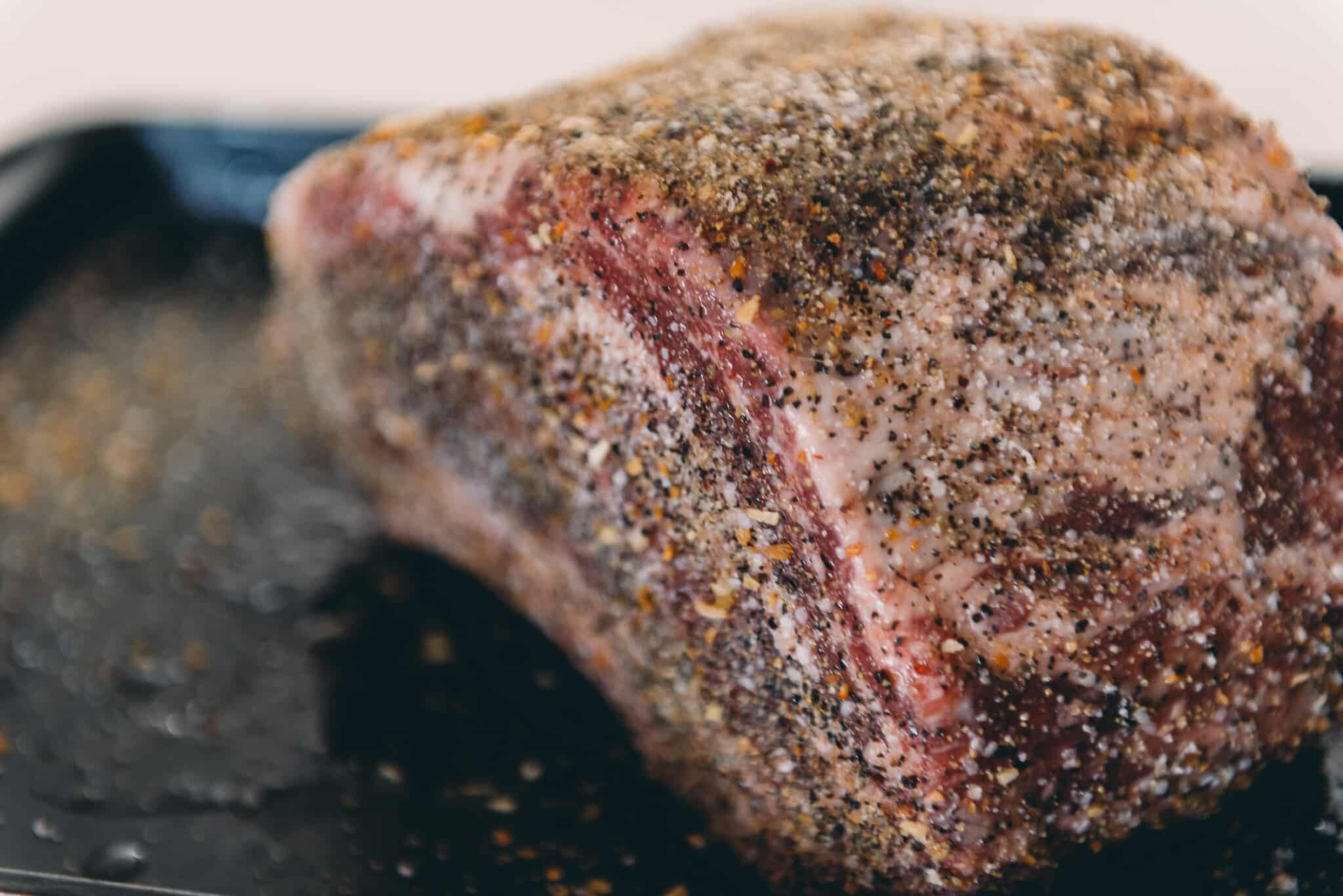
🔥 How to Cook Prime Rib (Choose Your Method)
The best way to cook prime rib is low and slow, then finish with high heat for a crust.
Prime rib is forgiving—as long as you cook to temperature, not time.
Oven-Roasted Prime Rib
Perfect for beginners. Slow roast at a low temperature for even doneness, then finish hot to crisp the crust. → Classic Garlic Herb Prime Rib
Reverse Sear Prime Rib
The most reliable way to get edge-to-edge medium-rare. Cook low and slow, then blast with high heat at the end. → Reverse Seared Prime Rib
Smoked Prime Rib
Low, slow, and kissed with wood smoke. The fat cap renders beautifully. → Smoked Prime Rib
Grilled Prime Rib
Direct + indirect heat layers on a deep crust and a hint of char. → Charcoal Grilled Prime Rib
Prime Rib on a Pellet Grill
Set it, forget it, get perfect smoky flavor. → Traeger Grill Prime Rib
Prime Rib on a Gas Grill
Great for anyone who wants smoke without a smoker. → Prime Rib on a Gas Grill
Sous Vide Prime Rib
The most precise method: flawless doneness from edge to edge. → Sous Vide Prime Rib
⏱️ Prime Rib Cooking Temps + Doneness Guide
Prime Rib Cooking Time Chart (General Guidelines)
Use a thermometer for accuracy; these are estimates.
| Weight of Roast | Oven Low & Slow (250°F) | Reverse Sear (225°F) | Smoker (225°F) |
|---|---|---|---|
| 4–5 lb | 2–2.5 hours | 2.5–3 hours | 3–3.5 hours |
| 6–7 lb | 2.5–3.5 hours | 3–4 hours | 3.5–4.5 hours |
| 8–9 lb | 3.5–4.5 hours | 4–5 hours | 4.5–5.5 hours |
Target Pull Temps
- Rare: 120–125°F
- Medium-Rare: 125–130°F → recommended
- Medium: 135–140°F
For a deeper breakdown of doneness levels and how temperature changes texture, explore our full Steak Temperature Guide
Resting Time
Let the roast rest 20–30 minutes so juices redistribute, and the final temp rises 5–7 degrees.
Meat Nerd Tip: A roast this large will have natural doneness zones—more done on the ends, pinker in the middle—so everyone gets what they want.
After Cooking: How to Carve Prime Rib
Once your roast is rested, carve it cleanly with our step-by-step guide. → How to Carve Prime Rib
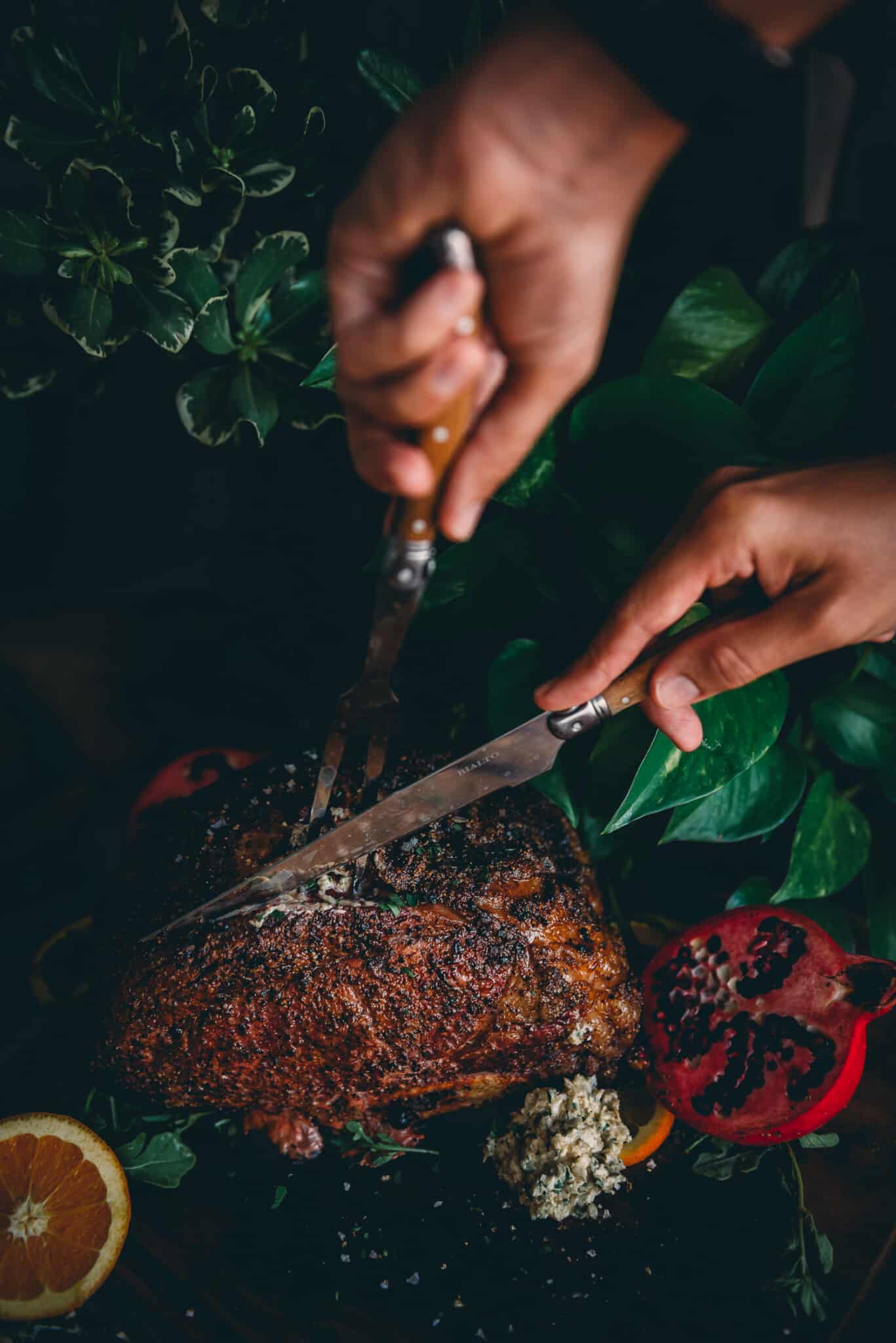
🔪 How to Trim Prime Rib
If the fat cap is thicker than ¼ inch, trim it down so it can render.
Steps:
- Place the roast fat-side up.
- Pat dry with paper towels.
- Trim only thick, hard fat—leave at least ¼ inch intact.
- Square off any thin or loose pieces.
- Save the trimmed fat for rendering or au jus.
Pro Tip: We love to season our roast with kosher salt and let it dry brine in the refrigerator for up to four days before cooking. This helps to create an epic crust on the surface and deepens the taste.
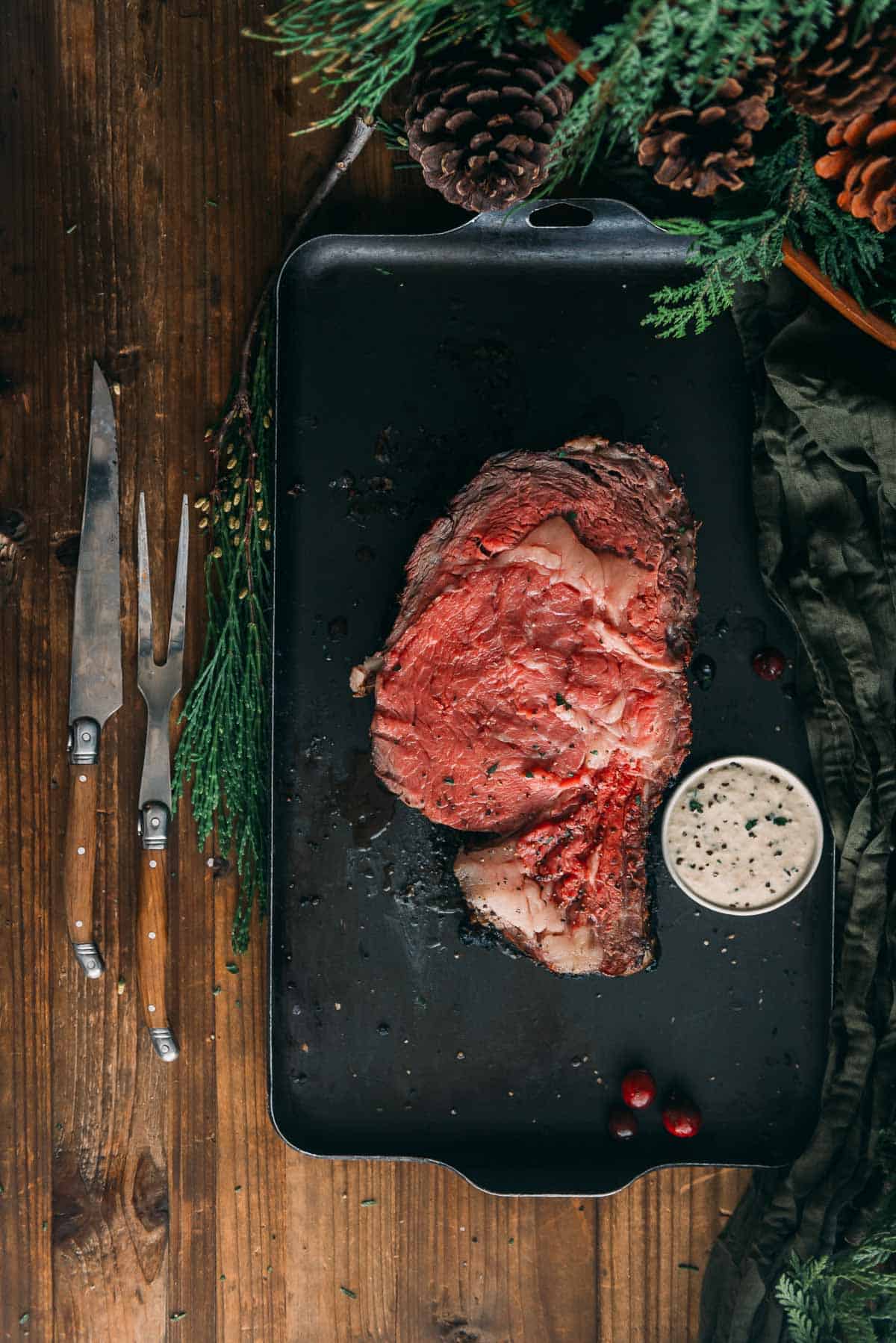
🍽️ Prime Rib Sauces
Add one of these to the table for restaurant-level luxury:
- Horseradish cream sauce
- Blue cheese sauce
- Brandy peppercorn sauce
- Red wine sauce
- Mushroom cream sauce
🥦 Best Side Dishes for Prime Rib
Prime rib is rich—pair it with sides that bring balance:
- Mashed potatoes
- Creamed leeks
- Roasted green beans
- Smoked mushrooms
- Yorkshire pudding (if you want to go classic)
girl carnivore expert tip
You can save the bones and make a roasted bone broth for future beef recipes.
🍷 Wine Pairings for Prime Rib
You want something bold enough to match the richness:
- Cabernet Sauvignon
- Merlot
- Syrah
- Malbec
If you prefer white wine, choose something rich like Chardonnay. A dry Champagne or Prosecco also works for contrast.
🍖 What Else Is Prime Rib Good For?
A full rib roast gives you options:
- Use leftovers for sandwiches, hash, or ragù
- Slice it into bone-in ribeye steaks for grilling
- Cut it into boneless ribeye steaks
- Save the bones for roasted beef bone broth
More helpful Meat Guides
❓ Prime Rib FAQs
Roasting or reverse searing gives the most even, reliable results. Reverse sear is the method we lean on for consistent medium-rare.
This beef roast comes from a naturally tender primal cut, has a high amount of marbling, and demand spikes around holidays. If you buy Prime grade, you’re paying for premium marbling.
Prime rib is the whole roast (often bone-in). Ribeye is a steak cut from that roast. Prime rib is is a bigger richer cut of meat; ribeye is more concentrated in flavor since it’s one steak from the whole rib.
Plan for 1 lb per person on a bone-in roast and ¾ lb per person for boneless.
The Best Prime Rib recipes
